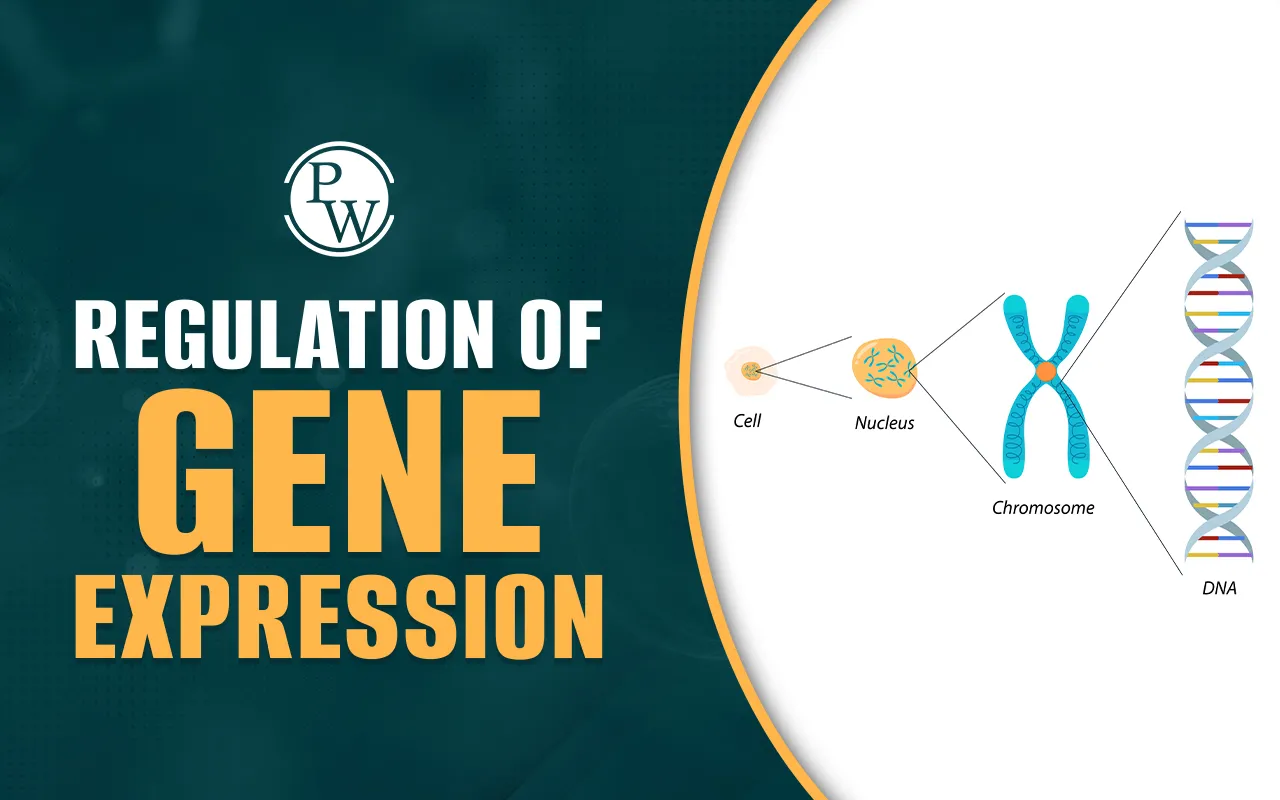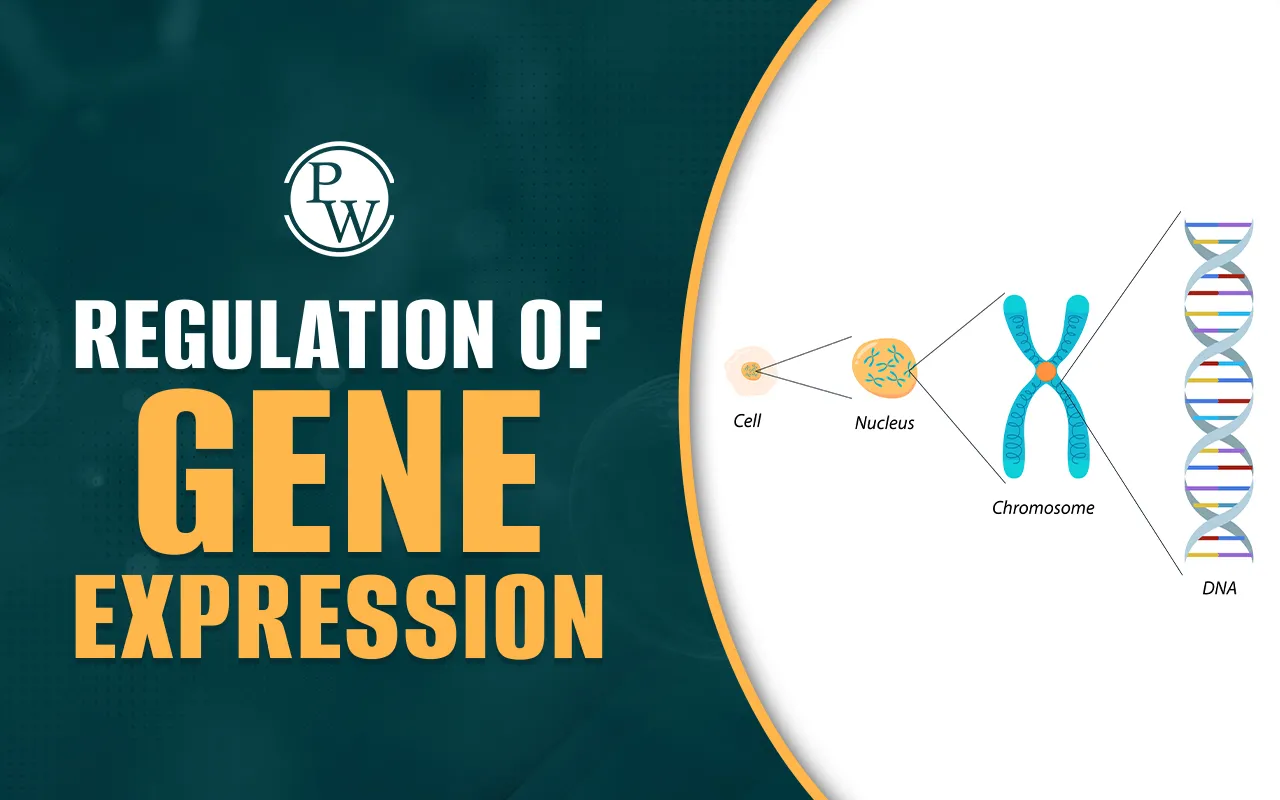

Regulation of Gene Expression: Gene expression is the process by which information from a gene is utilized to produce a functional product, typically a protein. This process is essential for cell function, and the regulation of gene expression is important for organisms to respond to their environment, develop, and maintain cellular functions. Also, there are many of these types of processes that are important for proper functioning.
Gene expression regulation happens at multiple stages in any cell or organism, allowing cells to control when and how much of a gene product is produced. Here, we will know the mechanisms of gene expression regulation, including operons in bacteria and differential gene expression in multicellular eukaryotes.
What is Regulation of Gene Expression?
Gene expression is the process by which information from our DNA is used to make proteins. First, DNA is turned into a message called messenger RNA (mRNA), and then mRNA helps make proteins. Basically, these proteins do different jobs in the body, like speeding up chemical reactions or giving support to cells.
All these processes are equally important to function properly. Gene expression regulation controls when and how much of each protein is made in any organism. This helps the body use energy wisely, respond to changes in the environment, and do important tasks like growth and fighting infections in an organism.
Gene Expression in Bacteria: The Role of Operons
In bacteria, gene expression is regulated primarily at the transcriptional level. An important feature of bacterial gene regulation is the presence of operons.
What is an Operon?
An operon is a group of genes that are co-regulated and transcribed together into a single mRNA molecule. These genes often encode proteins that are involved in the same biochemical pathway, allowing bacteria to efficiently regulate related genes simultaneously. Operons consist of several important components that are listed below:
-
Promoter: A region of DNA where RNA polymerase binds to start transcription.
-
Operator: A DNA sequence that acts as a regulatory site, either allowing or blocking RNA polymerase from transcribing the genes.
-
Genes: The actual coding sequences for proteins involved in a specific process or pathway. Basically, genes are passed on from parents to their children.
-
Regulatory Genes: These genes produce molecules like repressors or activators that control the operon’s expression.
Note: Understand these basic terms, and then only you will be able to understand more terms. These terms are the core concepts of this topic. Also, students will learn the basics of these in classes 11th and 12th.
The Lac Operon: A Classic Example
One of the most well-known examples of an operon in bacteria is the lac operon in Escherichia coli (E. coli). The lac operon controls the metabolism of lactose, a sugar found in milk. Basically, the operon consists of three structural genes (lacZ, lacY, and lacA), which code for enzymes that break down lactose.
-
In the absence of lactose, a repressor protein binds to the operator, preventing transcription of the lac operon genes. Basically, this ensures that the bacteria do not waste energy producing unnecessary enzymes.
-
In the presence of lactose, lactose binds to the repressor, causing it to change shape and release from the operator. I.e, this allows RNA polymerase to access the promoter and transcribe the genes necessary for lactose metabolism.
How Operons Allow Bacteria to Adapt?
The operon model provides bacteria with a highly efficient way to regulate gene expression in response to environmental conditions. If a particular nutrient, like lactose, is available, the genes for its metabolism can be turned on.
When the nutrient is no longer available, the operon is turned off, preventing unnecessary production of enzymes and conserving energy.
Gene Expression in Multicellular Eukaryotes: Differential Gene Expression
In multicellular eukaryotes, gene expression regulation is more complex due to the specialization of cells and the structure of the organism. Each cell in a multicellular organism contains the same DNA, but different cells express different sets of genes based on their function and type.
Basically, this phenomenon is known as differential gene expression and is important for the development and maintenance of an organism.
What is Differential Gene Expression?
Differential gene expression is when different cells in the body use different sets of genes. Even though all cells have the same DNA, not all genes are active in every cell.
For example, muscle cells use genes that help them contract, while nerve cells use genes that help them send signals. This process is very important for things like growth, where different types of cells form from the same DNA, and for keeping tissues and organs working properly throughout life.
Mechanisms of Differential Gene Expression
Differential gene expression in eukaryotes is regulated at several levels. Here are the main mechanisms:
1. Transcriptional Regulation
At the transcriptional level, gene expression is controlled by various proteins that interact with DNA. Key proteins include:
-
Transcription Factors: These proteins bind to specific DNA sequences near genes (enhancers or promoters) to either activate or repress transcription.
-
Enhancers and Silencers: DNA sequences that can increase or decrease the rate of transcription. Basically, these sequences can be located far from the gene they regulate and still have an effect.
Note - Transcription factors, along with enhancers and silencers, help determine which genes are expressed in a specific cell type at a given time. Candidates should know about these to perform well in their exams.
2. Post-Transcriptional Regulation
After mRNA is transcribed, its stability, processing, and translation can be regulated. For instance:
-
RNA Splicing: In eukaryotes, the initial mRNA transcript (pre-mRNA) often contains non-coding regions called introns. These introns are spliced out, and the remaining exons are joined together to form the mature mRNA. Alternative splicing can lead to the production of different proteins from the same gene, contributing to the diversity of proteins in different cell types.
-
mRNA Stability: The stability of mRNA determines how long it remains in the cell before being degraded. Some mRNA molecules are rapidly degraded, while others persist longer to produce more protein.
-
RNA Interference: Small RNA molecules, such as microRNAs, can bind to mRNA and prevent its translation or promote its degradation, providing another layer of regulation.
3. Translational and Post-Translational Regulation
Once mRNA is translated into protein, gene expression can be regulated further at the translational level:
-
Translation Initiation: Proteins that assist in translation initiation can control how much protein is produced from a given mRNA.
-
Protein Modification: After proteins are synthesized, they may undergo modifications like phosphorylation, acetylation, or glycosylation, which can activate or deactivate them. These modifications can alter the protein’s function and activity.
Gene Expression in Development: How Cells Specialize?
During development, cells go through a process called differentiation, where they start doing specific jobs. Gene expression is very important in this process. At first, all cells may look similar because they use the same set of genes.
As development continues, cells begin to use different genes, which makes them turn into different types like skin cells, muscle cells, or blood cells. The control of gene expression during development is managed by special proteins, RNA molecules, and changes in the DNA that turn certain genes on or off in specific cells.
Epigenetic Regulation: A Layer of Control
Definition - Epigenetics refers to changes in gene expression that do not involve changes to the DNA sequence itself. These changes can be passed down from one generation to the next.
In eukaryotes (organisms whose cells have a membrane-bound nucleus and other membrane-bound organelles), epigenetic regulation plays a major role in controlling gene expression. Key mechanisms include:
-
DNA Methylation: The addition of a methyl group to DNA, often at cytosine bases, can silence genes by preventing the binding of transcription factors.
-
Histone Modification: Histones are proteins around which DNA is wrapped. The addition of chemical groups to histones can either tighten or loosen the DNA, affecting gene expression.
How Differential Gene Expression Affects Development and Disease?
Differential gene expression is important for the proper development and tissue maintenance of any living being. Disruptions in this regulation can lead to diseases, including cancer and many more, which are very dangerous to health.
For instance, when genes that control cell growth are misregulated (i.e., improperly or incorrectly), it can lead to uncontrolled cell division, a hallmark of cancer, and we all know that these days cancer is spreading too fast due to our lifestyle issues.
Future of Gene Expression Research
The study of how gene expression is regulated is growing quickly with growing technology, thanks to new technologies like CRISPR-Cas9, which lets scientists edit genes exactly as though they are.
Now, researchers or scientists can learn how different genes work together and control each other in living organisms. This helps us understand things like development, diseases, and how to treat health problems related to all these, using methods like therapy, medicine, surgery, or physical therapy.
